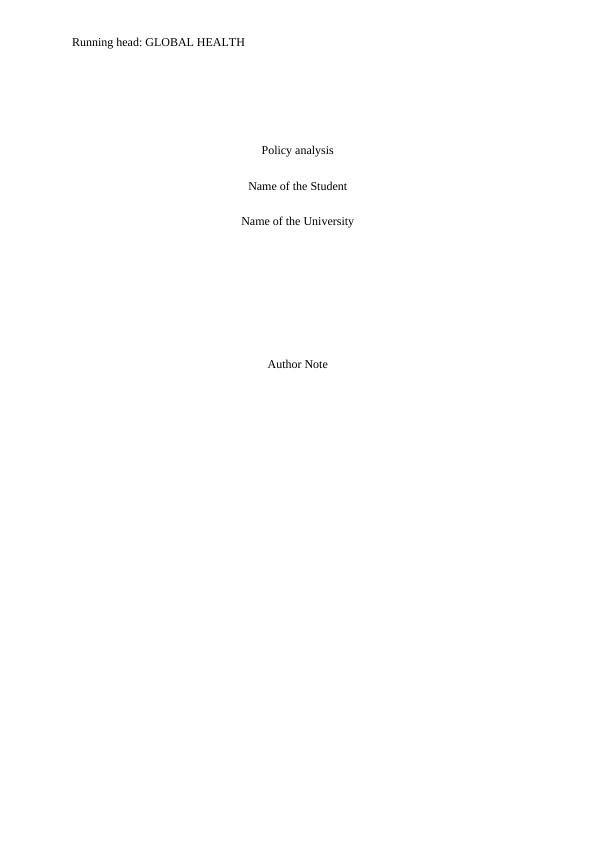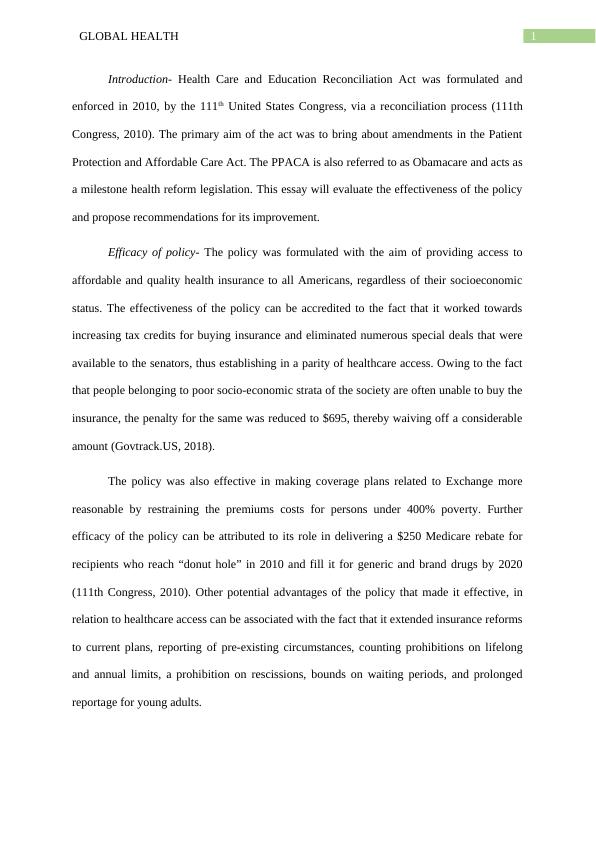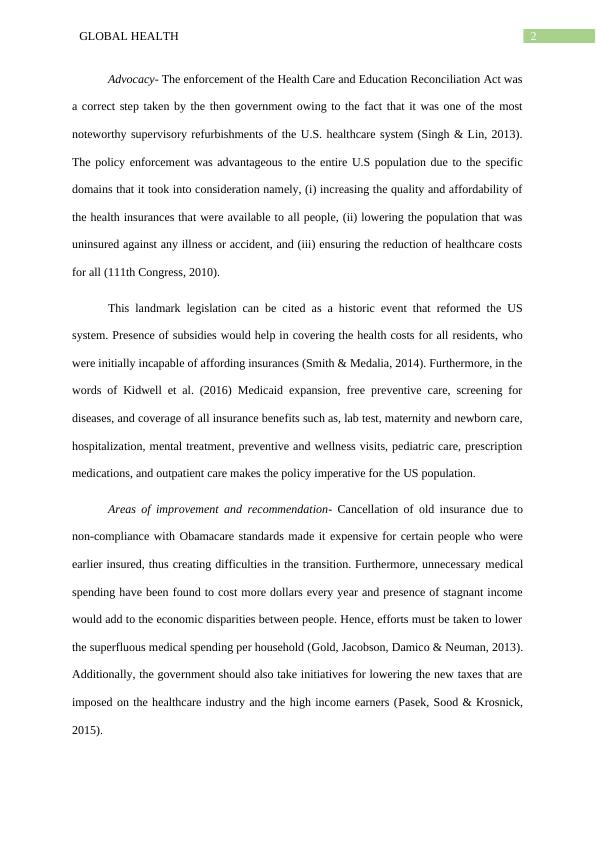Policy Analysis of Health Care and Education Reconciliation Act
Added on 2023-05-30
6 Pages1313 Words263 Views
Running head: GLOBAL HEALTH
Policy analysis
Name of the Student
Name of the University
Author Note
Policy analysis
Name of the Student
Name of the University
Author Note

1GLOBAL HEALTH
Introduction- Health Care and Education Reconciliation Act was formulated and
enforced in 2010, by the 111th United States Congress, via a reconciliation process (111th
Congress, 2010). The primary aim of the act was to bring about amendments in the Patient
Protection and Affordable Care Act. The PPACA is also referred to as Obamacare and acts as
a milestone health reform legislation. This essay will evaluate the effectiveness of the policy
and propose recommendations for its improvement.
Efficacy of policy- The policy was formulated with the aim of providing access to
affordable and quality health insurance to all Americans, regardless of their socioeconomic
status. The effectiveness of the policy can be accredited to the fact that it worked towards
increasing tax credits for buying insurance and eliminated numerous special deals that were
available to the senators, thus establishing in a parity of healthcare access. Owing to the fact
that people belonging to poor socio-economic strata of the society are often unable to buy the
insurance, the penalty for the same was reduced to $695, thereby waiving off a considerable
amount (Govtrack.US, 2018).
The policy was also effective in making coverage plans related to Exchange more
reasonable by restraining the premiums costs for persons under 400% poverty. Further
efficacy of the policy can be attributed to its role in delivering a $250 Medicare rebate for
recipients who reach “donut hole” in 2010 and fill it for generic and brand drugs by 2020
(111th Congress, 2010). Other potential advantages of the policy that made it effective, in
relation to healthcare access can be associated with the fact that it extended insurance reforms
to current plans, reporting of pre-existing circumstances, counting prohibitions on lifelong
and annual limits, a prohibition on rescissions, bounds on waiting periods, and prolonged
reportage for young adults.
Introduction- Health Care and Education Reconciliation Act was formulated and
enforced in 2010, by the 111th United States Congress, via a reconciliation process (111th
Congress, 2010). The primary aim of the act was to bring about amendments in the Patient
Protection and Affordable Care Act. The PPACA is also referred to as Obamacare and acts as
a milestone health reform legislation. This essay will evaluate the effectiveness of the policy
and propose recommendations for its improvement.
Efficacy of policy- The policy was formulated with the aim of providing access to
affordable and quality health insurance to all Americans, regardless of their socioeconomic
status. The effectiveness of the policy can be accredited to the fact that it worked towards
increasing tax credits for buying insurance and eliminated numerous special deals that were
available to the senators, thus establishing in a parity of healthcare access. Owing to the fact
that people belonging to poor socio-economic strata of the society are often unable to buy the
insurance, the penalty for the same was reduced to $695, thereby waiving off a considerable
amount (Govtrack.US, 2018).
The policy was also effective in making coverage plans related to Exchange more
reasonable by restraining the premiums costs for persons under 400% poverty. Further
efficacy of the policy can be attributed to its role in delivering a $250 Medicare rebate for
recipients who reach “donut hole” in 2010 and fill it for generic and brand drugs by 2020
(111th Congress, 2010). Other potential advantages of the policy that made it effective, in
relation to healthcare access can be associated with the fact that it extended insurance reforms
to current plans, reporting of pre-existing circumstances, counting prohibitions on lifelong
and annual limits, a prohibition on rescissions, bounds on waiting periods, and prolonged
reportage for young adults.

2GLOBAL HEALTH
Advocacy- The enforcement of the Health Care and Education Reconciliation Act was
a correct step taken by the then government owing to the fact that it was one of the most
noteworthy supervisory refurbishments of the U.S. healthcare system (Singh & Lin, 2013).
The policy enforcement was advantageous to the entire U.S population due to the specific
domains that it took into consideration namely, (i) increasing the quality and affordability of
the health insurances that were available to all people, (ii) lowering the population that was
uninsured against any illness or accident, and (iii) ensuring the reduction of healthcare costs
for all (111th Congress, 2010).
This landmark legislation can be cited as a historic event that reformed the US
system. Presence of subsidies would help in covering the health costs for all residents, who
were initially incapable of affording insurances (Smith & Medalia, 2014). Furthermore, in the
words of Kidwell et al. (2016) Medicaid expansion, free preventive care, screening for
diseases, and coverage of all insurance benefits such as, lab test, maternity and newborn care,
hospitalization, mental treatment, preventive and wellness visits, pediatric care, prescription
medications, and outpatient care makes the policy imperative for the US population.
Areas of improvement and recommendation- Cancellation of old insurance due to
non-compliance with Obamacare standards made it expensive for certain people who were
earlier insured, thus creating difficulties in the transition. Furthermore, unnecessary medical
spending have been found to cost more dollars every year and presence of stagnant income
would add to the economic disparities between people. Hence, efforts must be taken to lower
the superfluous medical spending per household (Gold, Jacobson, Damico & Neuman, 2013).
Additionally, the government should also take initiatives for lowering the new taxes that are
imposed on the healthcare industry and the high income earners (Pasek, Sood & Krosnick,
2015).
Advocacy- The enforcement of the Health Care and Education Reconciliation Act was
a correct step taken by the then government owing to the fact that it was one of the most
noteworthy supervisory refurbishments of the U.S. healthcare system (Singh & Lin, 2013).
The policy enforcement was advantageous to the entire U.S population due to the specific
domains that it took into consideration namely, (i) increasing the quality and affordability of
the health insurances that were available to all people, (ii) lowering the population that was
uninsured against any illness or accident, and (iii) ensuring the reduction of healthcare costs
for all (111th Congress, 2010).
This landmark legislation can be cited as a historic event that reformed the US
system. Presence of subsidies would help in covering the health costs for all residents, who
were initially incapable of affording insurances (Smith & Medalia, 2014). Furthermore, in the
words of Kidwell et al. (2016) Medicaid expansion, free preventive care, screening for
diseases, and coverage of all insurance benefits such as, lab test, maternity and newborn care,
hospitalization, mental treatment, preventive and wellness visits, pediatric care, prescription
medications, and outpatient care makes the policy imperative for the US population.
Areas of improvement and recommendation- Cancellation of old insurance due to
non-compliance with Obamacare standards made it expensive for certain people who were
earlier insured, thus creating difficulties in the transition. Furthermore, unnecessary medical
spending have been found to cost more dollars every year and presence of stagnant income
would add to the economic disparities between people. Hence, efforts must be taken to lower
the superfluous medical spending per household (Gold, Jacobson, Damico & Neuman, 2013).
Additionally, the government should also take initiatives for lowering the new taxes that are
imposed on the healthcare industry and the high income earners (Pasek, Sood & Krosnick,
2015).

End of preview
Want to access all the pages? Upload your documents or become a member.
Related Documents
Health Care Debate in USAlg...
|13
|2500
|469
Maintaining the Loyalty of Stakeholderslg...
|9
|1821
|58
Impact of Affordable Care Act on Emergency Practicelg...
|7
|3202
|352
Economics of the Affordable Care Act (ACA) from 2011-2014lg...
|9
|2081
|308
Impact of Patient Protection and Affordable Care Act (PPACA) on Health Care Organizationslg...
|8
|492
|399
Legal and Ethical Issues in Healthcare and Nursinglg...
|6
|1078
|56
